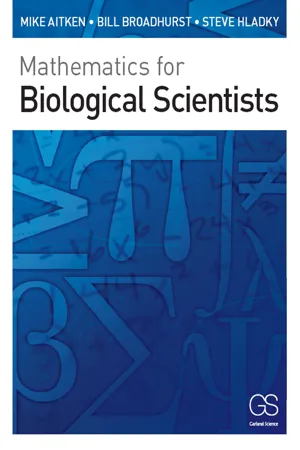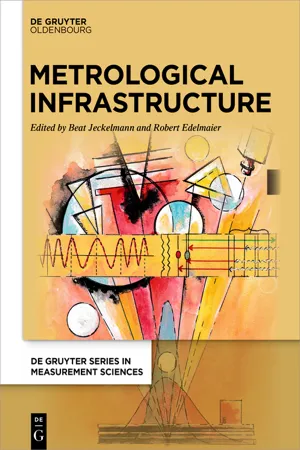Mathematics
Compound Units
Compound units are units that are formed by combining two or more fundamental units. These units are used to measure quantities that are derived from the fundamental units. Examples of compound units include meters per second (m/s) for speed and newtons per square meter (N/m²) for pressure.
Written by Perlego with AI-assistance
Related key terms
3 Key excerpts on "Compound Units"
- eBook - ePub
- Mike Aitken, Bill Broadhurst, Stephen Hladky(Authors)
- 2009(Publication Date)
- Garland Science(Publisher)
must specify the unit. The number and unit should be thought of as one whole, the quantity. For instance, in the equation for the distance traveled by a car accelerating at a constant rate from a standing start,d =(a1 / 2)t 2,(1.11) when the time t is squared both the number and the unit must be squared. If t = 3 s, then t2 = 9 s2 .1.4 Conversion of unitsThere are several different ways to remember how to change units. One of the safest (i.e. the easiest to get right every time) is based on a simple rule of algebra; we can always multiply anything by the number 1 without changing its value. The secret is to write the number 1 in a clever way. For example, because 1 kg = 1000 g, 1000 g/1 kg = 1, and a conversion from kilograms to grams can be written as
Note that we have also used kg/kg = 1 (as anything except 0 divided by itself equals 1).3.7 kg = 3 .7 kg ×= 3700 g.1000 g1 kg(EQ1.12) Any conversions we ever need to do are just applications of this principle. Suppose we have watched a leafcutter ant proceeding in a very businesslike manner carrying its leaf segment homeward. Because the pace was steady, the relation between the distance it moved d, the velocity v, and the time we watched, t, isd = v × t .(EQ1.13) Figure 1.4A leafcutter ant bearing its leaf back to the nest. To find out how fast it is moving, we can record its position at two times and divide the distance traveled by the time taken. Image courtesy of Bristol Zoo Gardens.The equation above relates the actual physical quantities: how fast it was traveling, the time, and the distance. If the elapsed time was 3 s and the distance traveled 36 mm then the velocity can be calculated as - eBook - ePub
- Beat Jeckelmann, Robert Edelmaier, Beat Jeckelmann, Robert Edelmaier(Authors)
- 2023(Publication Date)
- De Gruyter Oldenbourg(Publisher)
3 . We do not need a new independent unit to characterize the volume. This brings us to the important features of a system of units. It is characterized by a set of conventionally defined dimensions and the base units associated with them. The sizes of the base units are arbitrarily and independently fixed. In addition, there is an arbitrary number of derived units whose size and dimension depend on the conventionally-fixed base units. This dependence is determined by a mathematical equation. This equation also contains a constant to which one can assign any value and any dimensions. A system of units is called coherent if the derived units for a given system of magnitudes and a chosen set of base units are products of powers of base units, with the proportionality factors taking the value 1.3 Historical background to the International System of Units
3.1 From ancient measures to metric units
Fair trade in goods has always required units of measurement for length, weight, and volume set by the state or local authorities. Measures from ancient times in the form of artefacts have been preserved until today. The oldest known yardstick dates back to the 3rd millennium BC, was found in Nippur, Mesopotamia, and is called the Nippur cubit [8 ]. It is an impressive object, made of copper and with a weight of45 . 5 kg. The markings on the scale represent the units cubit, foot, and finger. The cubit is equal to51 . 8 cm. All premetric units of length can be derived from the Nippur cubit. In Egypt, around the same time, the royal cubit was introduced, a primary scale made of granite. Wooden copies of it served as working standards; they were periodically compared with the royal cubit. Even then, the principle of traceability applied, which is still the basic prerequisite for comparable measurements today. In the Middle Ages, too, measurements were used that could be derived from body masses. In the eighteenth century, however, there was still a great deal of chaos with regard to units of measurement. Every region had its own units. A measurement was inseparably linked to the measured object; it referred to a certain locally existing standard. To make matters worse, the technique of measuring also depended on local customs. This made trade more difficult and encouraged abuse and fraud. In his book, “ The Measure of the World” [1 - No longer available |Learn more
- Steven Boone, Drew H. Wolfe(Authors)
- 2011(Publication Date)
- Collins Reference(Publisher)
CHAPTER 2Chemical Measurements
I n this chapter, we will first discuss the International Standard of Units, the measurement system used by scientists throughout the world. Then, we will consider uncertainty in measurements and significant figures.2.1 INTERNATIONAL SYSTEM OF UNITSScientists have agreed upon a common set of units and standards, even though the U.S. general public uses a different system. Measurements Chemists make both qualitative and quantitative laboratory measurements. Each quantitative measurement expresses the magnitude, the units or label, and the degree of uncertainty. The SI System—A Metric SystemThe Systéme International d’Unités, or the International System of Units (SI), is the measurement system used in chemistry. The International System is a metric system. In the metric system, the conversion of a measurement from one unit to another requires only the shifting of the decimal point.SI Prefixes To scale a SI unit to the proper size for a measurement, the SI system has a series of prefixes that are appended to units. Exercises 2.1 and 2.2 review some of the more important prefixes. Exercise 2.1 What is the meaning of each of the following SI prefixes?(a) micro (μ), (b) mega (M), (c) milli (m), (d) deci (d)Solution 2.1(a) 1 × 10-6 ×, (b) 1 × 106 ×, (c) 0.001 ×, (d) 0.1 ×Exercise 2.2What prefix is used for each of the following: (a) 0.01 ×, (b) 1 × 10-9 ×, (c) 1,000 ×, (d) 1 × 10-12 ×?Solution 2.2 (a) centi, c; (b) nano, n; (c) kilo, k; (d) pico, p Base and Derived SI UnitsAll SI units may be derived from seven base units. They include the following: meter (m), unit of length; kilogram (kg), unit of mass; second (s), unit of time; Kelvin (K), unit of temperature; mole (mol), unit of amount of substance; ampere (A), unit of current; and candela (cd), unit of luminous intensity.All other units in the SI system are derived from combinations of seven base units. These are called derived units. Examples of derived SI units include m2 (area), m3 (volume), kg/m3 (density), and kg m2 /s2
Index pages curate the most relevant extracts from our library of academic textbooks. They’ve been created using an in-house natural language model (NLM), each adding context and meaning to key research topics.


